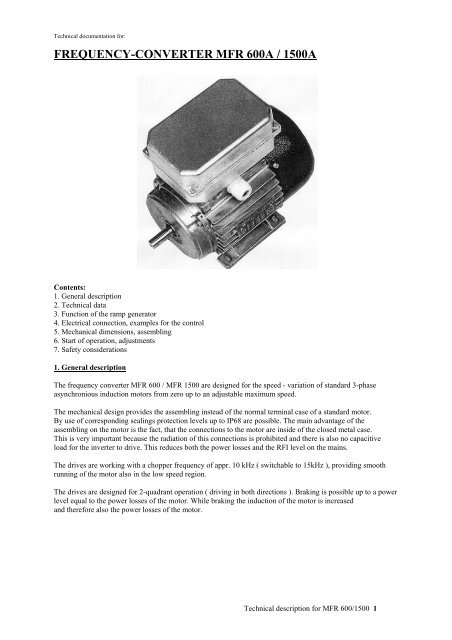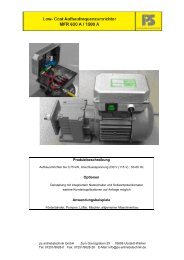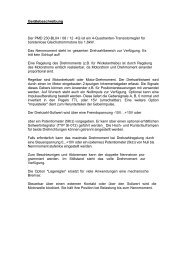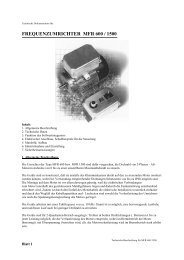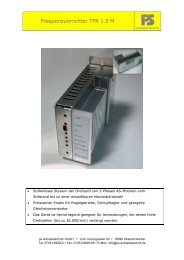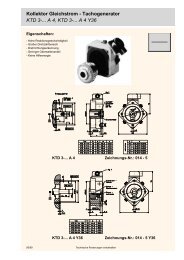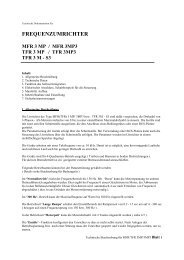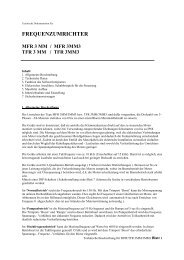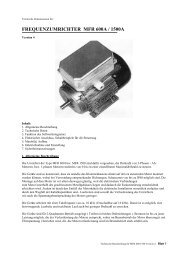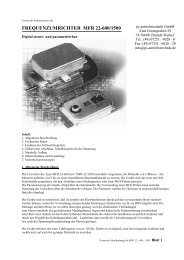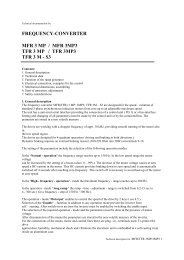FREQUENCY-CONVERTER MFR 600A / 1500A - PS Antriebstechnik
FREQUENCY-CONVERTER MFR 600A / 1500A - PS Antriebstechnik
FREQUENCY-CONVERTER MFR 600A / 1500A - PS Antriebstechnik
You also want an ePaper? Increase the reach of your titles
YUMPU automatically turns print PDFs into web optimized ePapers that Google loves.
Technical documentation for:<br />
<strong>FREQUENCY</strong>-<strong>CONVERTER</strong> <strong>MFR</strong> <strong>600A</strong> / <strong>1500A</strong><br />
Contents:<br />
1. General description<br />
2. Technical data<br />
3. Function of the ramp generator<br />
4. Electrical connection, examples for the control<br />
5. Mechanical dimensions, assembling<br />
6. Start of operation, adjustments<br />
7. Safety considerations<br />
1. General description<br />
The frequency converter <strong>MFR</strong> 600 / <strong>MFR</strong> 1500 are designed for the speed - variation of standard 3-phase<br />
asynchronious induction motors from zero up to an adjustable maximum speed.<br />
The mechanical design provides the assembling instead of the normal terminal case of a standard motor.<br />
By use of corresponding sealings protection levels up to IP68 are possible. The main advantage of the<br />
assembling on the motor is the fact, that the connections to the motor are inside of the closed metal case.<br />
This is very important because the radiation of this connections is prohibited and there is also no capacitive<br />
load for the inverter to drive. This reduces both the power losses and the RFI level on the mains.<br />
The drives are working with a chopper frequency of appr. 10 kHz ( switchable to 15kHz ), providing smooth<br />
running of the motor also in the low speed region.<br />
The drives are designed for 2-quadrant operation ( driving in both directions ). Braking is possible up to a power<br />
level equal to the power losses of the motor. While braking the induction of the motor is increased<br />
and therefore also the power losses of the motor.<br />
Technical description for <strong>MFR</strong> 600/1500 1
By means of a DIP-switch ( detailled description at 6.2 ) the drives can be switched to the following operation<br />
modes:<br />
In the ‘Normal - operation’ the frequency range reachesup to 150 Hz. In the low speed range the motor voltage<br />
can be increased by the adjustment of trimpot ‘Boost’ ( P1 ). The increase of the motor voltage causes at zero<br />
speed a DC-current in the motor. This DC-current provides braking down to zero speed and is automatically<br />
switched off 4 seconds after reaching zero frequency. This switch off is necessary to avoid heat-up of the motor<br />
at zero speed.<br />
In the ‘ Pump - operation’ - mode the maximum frequency reaches only 55 Hz and the ramp time is fix at<br />
5 sec. The trimpotis ‘ Boost’ and ‘Ramp’ are in this operation mode not active. In This mode the voltage to<br />
frequency - ratio is reduced with the frequency. This reduces the power - losses of the motor at reduced speeds.<br />
In the ‘High - frequency - operation’ - mode the maximum frequency - range reaches up to 600 Hz. In this<br />
mode the trimpot ‘boost’ is used to adjust the required voltage to frequency - ratio.<br />
In the operation - mode ‘ long ramp ‘ the ramp - time - adjustment - range is switched from 0.2-15 sec to<br />
4 - 300 sec ( for a frequency - step of 150 Hz / 600 Hz ). This Mode is not combinable with the pump-operation<br />
mode.<br />
The operation - mode ‘Motorpot’ enables to control the speed of the drive by 2 keys ( see 4.5 ).<br />
The operation - mode ‘200 Hz’ let the inverter automatically speed up to 200 Hz after switch on. The ramp-time<br />
is fixed to 1 sec, all control - signals and trimpotentiometers are inactive.<br />
The selection of the required operation - mode without voltage on the mains and inside the inverter. After<br />
disconnecting the drive from the mains the circuit needs appr. 30 sec to be free of voltage. After this time a<br />
switch from one to another operation - mode can be done.<br />
For the connections of the mains, motor and control lines there are plug - in - terminals used. To protect the<br />
drive against dust, humidity, mechanical shock and vibrations the electronic unit is embedded in a soft casting<br />
resin inside an aluminium case.<br />
The control - imputs of the drive are protection - isolated ( in accordance with VDE 0884 ). The drives are also<br />
protected against a direct short between motor - lines or between motor - line and earth.<br />
The electronic limiter of the motor - current allows at case temperatures up to 70°C a maximum motor -<br />
power of appr. 150 % of nominal power.<br />
The thermal - protection is switching off the drive at appr. 85°C. The reset of the thermal switch off must be<br />
done by switch off the mains for at least 10 sec.<br />
To control the drive signals from potentiometer, ext. voltage 0...10V, ext. current 0...20 mA or 4...20 mA are<br />
possible. The adaption of the input - circuit to correspond to the control - signal is made by the jumper B1<br />
and B2.<br />
Attention! If the input - circuit is set for control from a potentiometer or with 0...10 V, a disconnection of the<br />
control - input ( terminal 2 ) causes a control signal of half the adjusted maximum! Open control - input is<br />
therefore to be avoided.<br />
To enable the drive a closed loop must be connected to the enable - input.<br />
The temperature protection circuit of the motor is designed to accept loops with up to 1040 ohm as closed loops,<br />
higher resistance values as open loops. This makes it possible to use a PTC - sensor or a thermistor<br />
in the motor.<br />
The drive delivers an output signal (Inverter OK) if mains is ok and no error is detected.<br />
Control - lines with a length of more than 2 meters must be shielded. The shield should be connected to<br />
terminal 4. Below the length of 2 meters shielding is recommanded if a high disturbance - level is present in the<br />
surrounding.<br />
Technical description for <strong>MFR</strong> 600/1500 2
2. Technical data<br />
<strong>MFR</strong> 600 A <strong>MFR</strong> 1500 A<br />
Mains - voltage 230 VAC 230 VAC<br />
With reduced load switchable to 115 VAC 115 VAC<br />
Tolerance of the mains-voltage +- 15% +- 15%<br />
Frequency of the mains-voltage 50 - 60 Hz 50 - 60 Hz<br />
recommanded fuse in the mains 6.3 A slow 10 A slow<br />
rec. max. motor size 375 W 750 W<br />
Nominal voltage of the motor 3 X 230 VAC 3 X 230 VAC<br />
Motor - current ( max. at 30°C case-temp.) >3 A RMS >5.5 A RMS<br />
Temperature - range ( case - temperature ) 0...70°C 0...70°C<br />
Mechanical size 150 X 100 X 70 mm 150 X 100 X 70 mm<br />
Weight 0.85 kg 0.88 kg<br />
Output - frequency - ranges:<br />
- Normal - operation 0...150 Hz<br />
- Pump - operation 0...55 Hz<br />
- High - frequency - operation 0...600 Hz<br />
Adjustment - range of the min. frequency (trimpot P4) 0...50% of the preadjusted maximum<br />
Ramp - times:<br />
Normal - operation, frequency - step = 150 Hz<br />
- DS 5 off 0.1 ... 15 sec<br />
- DS 5 on 4 ... 300 sec<br />
High - frequency - mode, frequency step = 600 Hz<br />
- DS 5 off 0.2... 15 sec<br />
- DS 5 on 1.5 ...250sec<br />
Pump - operation - mode, frequ. step = 55 Hz 7 sec<br />
200 Hz - operation - mode 1 sec<br />
Control - signals:<br />
B1 and B2 open Poetentiometer or ext. voltage 0...10 VDC<br />
B1 closed, B2 open 0 ... 20 mA DC<br />
B1 and B2 closed 4 ... 20 mA DC<br />
Input - resistance of the control - input:<br />
B1 open > 500 kohm<br />
B1 closed 470 ohm<br />
Enalble - signal: closed loop , 10V / 1 mA DC<br />
Reversing - signal: open / closed loop, 10 V / 1 mA DC<br />
Temperatur protection input: closed loop with R < 1040 ohm<br />
Loop current appr. 1 mA<br />
Inverter OK – output : open collector NPN,<br />
max. load 27V DC / 100 mA<br />
Technical description for <strong>MFR</strong> 600/1500 3
3. Function of the ramp - generator:<br />
3.1 Normal - or high - frequency - operation - mode:<br />
The adjustment of the ramp - time is made by trimpot P2.<br />
With DS 5 ‘off’ the range of t is 0.1 ... 15 sec. ( for a frequ. step of 150 Hz resp. 600 Hz )<br />
With DS 5 ‘on’ the range of t is 1.5 ... 250sec.<br />
3.2 In the mode ‘pump - operation’ the ramp - time is fixed to 7 sec. ( for a frequ. step of 55 Hz ).<br />
3.3 In the operation - mode ‘200 Hz’ the ramp time is fixed to 1 sec.<br />
4. Electrical connection and examples for the control of the drive:<br />
4.1 Control by potentiometer:<br />
F D<br />
T<br />
OK<br />
8 7 6 5 4 3 2 1<br />
D = direction<br />
F = enable<br />
T = Motor-temp.<br />
OK = Inverter OK<br />
set-point<br />
U<br />
V<br />
motor<br />
3x230V<br />
W PE N<br />
L1<br />
L1<br />
N<br />
PE<br />
mains 230 VAC<br />
Technical description for <strong>MFR</strong> 600/1500 4
4.2 Control by external voltage 0...10 V DC:<br />
F D<br />
T ext. control<br />
= voltage<br />
0...10V DC<br />
+<br />
OK<br />
8 7 6 5 4 3 2 1<br />
D = direction<br />
F = enable<br />
T = Motor-temp.<br />
OK = Inverter OK<br />
4.3 Control by external current 0...20 mA DC ( 4 ... 20 mA DC ):<br />
F<br />
D<br />
T<br />
OK<br />
8 7 6 5 4 3 2 1<br />
D = direction<br />
F = enable<br />
T = Motor-temp.<br />
OK = Inverter OK<br />
=<br />
+<br />
ext. control<br />
current<br />
0...20mA<br />
rsp. 4...20mA<br />
4.4 Control by 2 keys in the mode ‘Motorpot’:<br />
F<br />
D<br />
T<br />
OK<br />
D = direction<br />
F = enable<br />
T = Motor-temp.<br />
OK = Inverter OK<br />
control keys<br />
8 7 6 5 4 3 2 1<br />
- key<br />
+ key<br />
5. Mechanical dimensions, assembling on the motor:<br />
Technical description for <strong>MFR</strong> 600/1500 5
( Drawn is one possible assembling. In accordance to the requirements the drive can also be assembled in<br />
different modes )<br />
Assembling - steps:<br />
Upper part with the inverter<br />
Lower part<br />
Motor<br />
Range for the cableterminations<br />
Sealing<br />
Sealing<br />
1. Drilling and milling of the lower part of the case in accordance to the flange of the motor - terminal - case.<br />
Drilling the holes for the cable - terminations.<br />
Caution! Take care that the capacitors of the drive do not bump into the terminals of the motor!<br />
2. Assembling of the lower part of the case on the motor.<br />
3. Assembling of the cable - terminations.<br />
4. Assembling and fastening of the cables.<br />
5. Connecting of the plug-in - terminals to the wires of the cables and the motor.<br />
6. Placing the seal.<br />
7. Plug - in the connectors to the converter.<br />
9. Fixing of the upper case on the lower case.<br />
Technical description for <strong>MFR</strong> 600/1500 6
6. Start of operation, adjustments:<br />
Because of the fact, that an adjustment is impossible if the drive is assembled, parameters and limits must be<br />
adjusted before assembling.<br />
It is recommanded to make the requ. adjustments within the incoming inspection.<br />
For OEM applications we offer as a special service without additional costs to make the adjustments within the<br />
final inspections in our house.<br />
6.1 Position of the switches, jumpers and trimpots:<br />
P1<br />
Boost<br />
P4<br />
Min.<br />
P2<br />
Ramp<br />
DS6<br />
DS5<br />
DS4<br />
DS3<br />
DS2<br />
DS1<br />
on off<br />
P3<br />
Max.<br />
Jumper<br />
B1<br />
B2<br />
DIP-switch<br />
6.2 Selection of the requ. operation - mode: DS1 DS2<br />
Normal operation ON ON<br />
Pump operation OFF ON<br />
High frequency operation ON OFF<br />
200 Hz operation OFF OFF<br />
Selection of the requ. Additional modes ( can be combined ):<br />
Control mode ‘Motorpot’ DS 3 ON<br />
Clock frequency 16 kHz DS 4 ON<br />
Long ramptime DS 5 ON<br />
Inverter not self – starting DS 6 ON<br />
Selection of the control modes:<br />
Control by potentiometer or ext. Voltage 0…10V: B1 and B2 open<br />
Control by current 0…20 mA: B1 closed, B2 open<br />
Control by current 4…20 mA: B1 and B2 closed<br />
6.3 Adjustment of the trimpotis in the ‘Normal - operation’ - mode:<br />
Technical description for <strong>MFR</strong> 600/1500 7
6.31 Connect mains, motor and control - circuits.<br />
6.32 Switch on mains, close the enable - loop.<br />
Turn set - point - potentiometer to the maximum CW.<br />
Adjust the requ. maximum speed at trimpot P3.<br />
6.33 Turn set - point - potentiometer to the maximum CCW.<br />
Adjust the requ. minimum speed at trimpot P4.<br />
6.34 Turn the set - point - potentiometer fast from CCW to CW and return.<br />
Adjust the requ. ramp time at trimpot P2.<br />
6.35 If in the low - speed -range additional torque is necessary, adjust the boost - ratio<br />
at trimpot P1.<br />
6.4 Adjustment of the trimpotis in the ‘High - frequency’ - operation mode:<br />
The adjustment runs similar to 6.31 - 6.34. The requ. voltage to frequency - ratio must be adjusted at<br />
trimpot P1, the ‘boost’ - function is inactive.<br />
6.5 Adjustment of the trimpotis in the ‘Pump - operation’ - mode:<br />
The adjustment runs similar to 6.31 - 6.33, steps 6.34 and 6.35 are inactive.<br />
After this adjustments the converter - unit can be assembled on the motor and operation can start.<br />
7. Safety considerations<br />
The following safety considerations must be observed during all phases of operation, service and repair of this<br />
device. Failure to comply with this precautions violates the intended use of this device.<br />
To minimize the shock - hazard the drive must be connected to an electrical ground. Terminal PE or the metalcase<br />
must be connected to the electrical ground ( safety - ground ) of the power - outlet.<br />
Do not operate in an explosive atmosphere!<br />
Operation of this device in the presence of flammable gases, fumes or dusts may cause of an ignition of this<br />
atmosphere and is to prevent.<br />
CAUTION!<br />
To prevent potential shock hazards do not expose this device in the open state to moisture, rain or wetness.<br />
Wetness inside the case may cause an electrical connection between mains and the inputs.<br />
Installation, ajustment and service of this device must be made by qualified personal. Works at the electrical<br />
parts of the device are very dangerous because of the high voltage the device is working with. This high voltage<br />
is capable of causing death and is present even after disconnecting mains. Before starting of service it is<br />
necessary to wait at least 30 sec. after disconnecting mains.<br />
This device must not used as an electrical disconnection. It is not allowed to work at the output lines without a<br />
mechanical disconnection from mains, even if the driven motor does not carry voltage or current.<br />
Do not attempt internal service or adjustment unless another person, capable of disconnecting mains and<br />
rendering first aid is present.<br />
Do not touch the electrical parts of this device. During operation the electrical parts are carrying dangerous<br />
voltages. Out of operation a touch may cause a defect by electrostatic discharge.<br />
To prevent additional hazards, do not make modifications at this device.<br />
Technical description for <strong>MFR</strong> 600/1500 8


